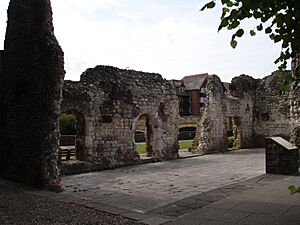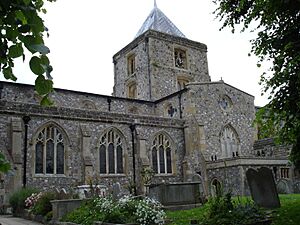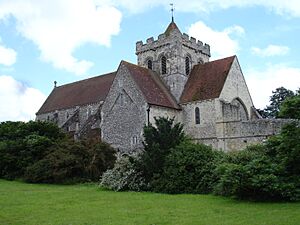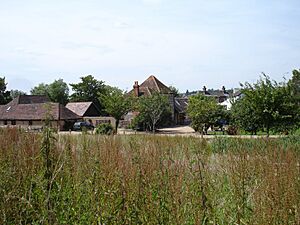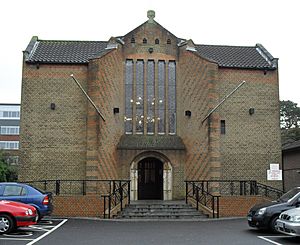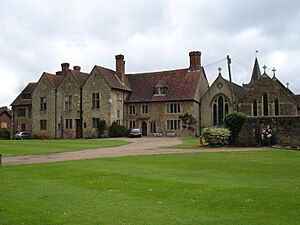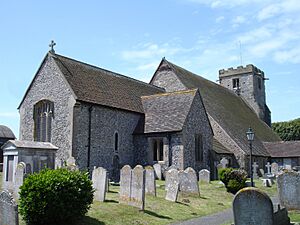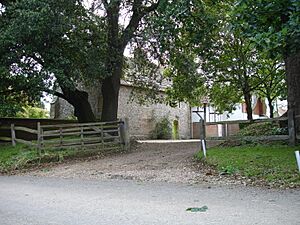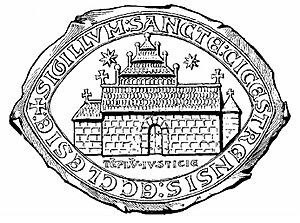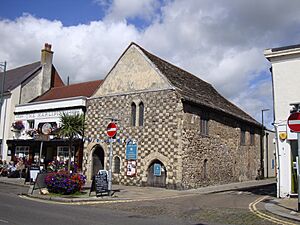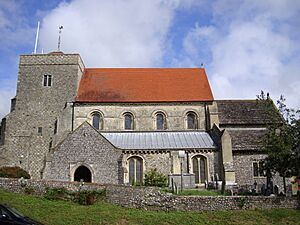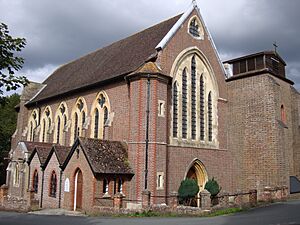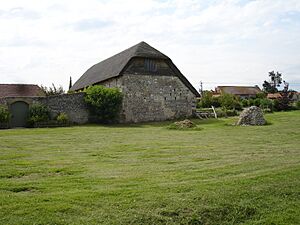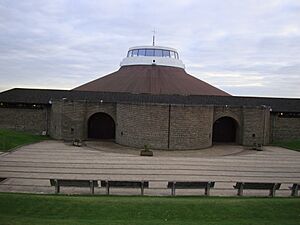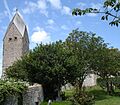List of monastic houses in West Sussex facts for kids
This page lists the monastic houses in West Sussex, England. Monastic houses are places where groups of religious people, like monks, nuns, or friars, lived together under special rules. These places include abbeys, priories, and friaries.
Alien houses are included, as are smaller establishments such as cells and notable monastic granges (particularly those with resident monks), and also camerae of the military orders of monks (Knights Templars and Knights Hospitaller). Monastic hospitals are included where they had the status or function of an abbey, priory, friary or preceptor/commandery.
- Abbreviations and key
| Symbol | Status |
|---|---|
| None | Ruins |
| * | Current monastic function |
| + | Current non-monastic ecclesiastic function (including remains incorporated into later structure) |
| ^ | Current non-ecclesiastic function (including remains incorporated into later structure) or redundant intact structure |
| $ | Remains limited to earthworks etc. |
| # | No identifiable trace of the monastic foundation remains |
| ~ | Exact site of monastic foundation unknown |
| ≈ | Identification ambiguous or confused |
Locations with names in italics indicate possible duplication (misidentification with another location) or non-existent foundations (either erroneous reference or proposed foundation never implemented) or ecclesiastical establishments with a monastic name but lacking actual monastic connection.
| EH | English Heritage |
| LT | Landmark Trust |
| NT | National Trust |
| Foundation | Image | Communities & History | Formal Name or Other Names |
|---|---|---|---|
| Aldingbourne Monastery | A monastery and church were given land by King Nothhelm in 692 for his sister. Later, this gift was given to St Wilfrid. | ||
| Arundel Blackfriars | Dominican Friars (a type of friar) They were founded before 1253. The friary was closed down in 1538. |
Arundel Blackfriars | |
| Arundel Priory, earlier site | Benedictine monks This was an alien house, meaning it was controlled by a monastery in Séez, France. Land was given to Séez by Roger de Montgomery before 1094. A monastery was set up in 1102. It moved to a new site in 1177. |
||
| Arundel Priory | Secular canons (priests living by certain rules) Founded before 1177. Benedictine monks The monks moved here from their earlier site in 1177, taking the place of the canons. It was an alien house, dependent on Séez. The monks left by 1379. It became a college for priests in 1380. It was closed in 1544. Parts of the old college buildings are now part of St Winifred's Priory, a convent from the 1800s. |
The Parish and Priory Church of Saint Nicholas, Arundel | |
| Atherington Priory | Benedictine monks This was a small branch (called a cell or grange) of the Séez monastery. It was likely founded before 1102. It closed around 1414 and was given to Syon Abbey. Only the chapel remains, used for the ashes of the Moynes family. |
||
| Bosham Monastery | Monks Founded before 681 by Dicul, an Irish monk. It later belonged to Osbern, a chaplain to King Edward the Confessor. Secular canons (from Plympton) This was a college (a group of clergy living together). Founded around 1121. It closed around 1553. |
||
| Boxgrove Priory | A college of priests existed here before 1066. Benedictine monks This was an alien house, dependent on Lessay, France. Founded around 1117 by Robert de la Haye. It became denizen (independent) after 1339. It was closed in 1536 and given to Henry, Earl of Arundel, in 1560 or 1561. Part of the church is still used as a local parish church today. |
The Priory Church of Saint Mary the Virgin and Saint Blaise, Boxgrove ____________________ Boxgrave Priory |
|
| Calcetto Priory, Lyminster |
Augustinian Canons Regular (a type of priest living in a community) Founded before 1151 by Queen Adelisa, King Henry I's widow. It was closed in 1525 by Cardinal Wolsey. The remains are now part of a farmhouse called 'Calcetto'. |
The Priory Church of Saint Bartholemew, Pynham The Priory Church of Saint Bartholemew and Saint Thomas of Canterbury, Pynham ____________________ Pynham Priory; Pyneham Priory; Priory de Calceto (Priory of the Causeway) |
|
| Chichester Austin Friars | Augustinian Friars This was a former Franciscan house. It was planned to be given to the Augustinians in 1269, but this never happened. (See Chichester Greyfriars, earlier site). |
||
| Chichester Blackfriars | Dominican Friars Founded before 1280. It was closed in 1538 and given to the Mayor and citizens of Chichester in 1540 or 1541. |
||
| Chichester Greyfriars, earlier site | Franciscan Friars Minor, Conventual Founded before 1232. They moved to a new site in 1269. This site was then planned for the Augustinian Friars, but it was too close to the Franciscans' new location. It was given to St Mary's Hospital in 1285. St Mary's Hospital now stands on this site. |
||
| Chichester Greyfriars | Franciscan Friars Minor, Conventual The community started at an earlier site before 1232. They moved here in 1269. It was closed on October 8, 1538. The chancel (part of the church) is now in Priory Park and is part of the City Museum. |
||
| Chichester Priory | A college of priests was founded before 956. Benedictine? nuns It was re-established before 1066. The nuns were replaced by canons in 1075 when the bishop's seat moved from Selsey to Chichester. |
St Nicholas | |
| Crawley Friary | Capuchin Franciscan Friars Founded in 1861. It is still active today. |
SS Francis and Anthony | |
| Crawley Down Monastery | Community of the Servants of the Will of God (Anglican) It is still active today. |
The Monastery of the Holy Trinity, Crawley Down, Crawley | |
| Dureford Abbey | Premonstratensian Canons (a type of priest living in a community) They came from Welbeck Abbey in Nottinghamshire. It was a "daughter house" of Welbeck, meaning it was a new branch. Founded before 1183 by Henry Husey. It was closed between 1534 and 1536 and given to Sir William Fitz Williams in 1537 or 1538. Small parts of the abbey are now part of a farmhouse and stable. |
The Abbey Church of the Blessed Virgin Mary and Saint John the Baptist, Dureford ____________________ Durford Abbey |
|
| Easebourne Priory | Benedictine nuns Founded around 1238, possibly by Sir John de Bohun. Augustinian Canonesses It might have been re-established in the 1400s. It was closed in 1536 and given to Sir William FitzWilliam in 1536 or 1537. Parts of the cloister (a covered walkway) are now part of a house. The restored refectory (dining hall) is now used as a local church. |
St Mary the Nativity of the Blessed Virgin Mary (early 16th century) |
|
| Farnham Minster | Land was given by King Caedwalla in 688 for a minster (a type of church or monastery). However, there is no proof that a monastery was actually built there. |
||
| Ferring Monastery (?) | This might have been a Saxon church, chapel, or monastery between 757 and 796. | ||
| Hardham Priory | Augustinian Canons Regular Founded after 1248. It was closed in 1534. A farmhouse and garden now stand on the site. |
St Cross | |
| Priory of Our Lady of Good Counsel (Sayers Common) | Canonesses Regular of Windesheim (a type of nun). It is still active today. |
The Priory Church of Our Lady of Good Counsel | |
| Lyminster Priory | Possibly a Saxon royal minster (Nonnaminstre). Benedictine nuns or canonesses This was an alien house, a small branch dependent on Almeneches, France. Founded around 1082 by Roger de Montgomery. It is now the Parish Church of St Mary Magdalene. It was closed around 1414. |
St Mary ____________________ Nonnaminstre? |
|
| Poling Preceptory | Knights Hospitaller (a military religious order) Founded before 1199. Land was given by Ralph fitz Savarac and confirmed by King John. The last prior (leader) died in 1442. It was closed in 1445 and became part of the holdings of the Prior of England. |
St John's Priory | |
| Runcton Priory | Benedictine monks Founded before 1086. This was an alien house, a small branch dependent on Troarn, France. Land was given to Troarn by Roger de Montgomery after 1100. It was closed in 1260 and given to Bruton in Somerset. |
||
| Rusper Priory | Benedictine nuns Founded before 1200, probably by the de Braose family. It was closed in 1537 and given to Sir Robert Southwell in 1537 or 1538. A house now stands on the site. |
The Priory Church of Saint Mary Magdalene, Rusper ____________________ Ruspur Priory |
|
| Saddlescombe Preceptory | Knights Templar (another military religious order) Founded around 1228. Land was given by Geoffrey de Say. It was closed between 1308 and 1312. Knights Hospitaller They took over around 1308-1312. It might have just been a small part of Shipley after the Knights Templar were shut down. A house called 'Saddlescombe Manor' might be on the original site. |
||
| Sele Priory | A college of priests was founded before 1073 by William de Braose. Benedictine monks This was an alien house, dependent on St-Florent-de-Saumur, France. It was given to St-Florent in 1080. Founded before 1126. It became denizen (independent) from 1396. It was given to Magdalen College, Oxford, in 1459. It was closed in 1480. The buildings were used by Carmelite Friars in 1493. |
St Peter; ____________________ Beeding Priory |
|
| Sele Whitefriars | Carmelite Friars (a type of friar) from Shoreham. Founded in 1493. The Carmelites moved into the empty Benedictine buildings. It was closed in 1538. Its remains are probably part of the vicarage built on the site in 1792. |
SS Peter and Paul | |
| Selsey Abbey | Benedictine? monks Founded after 681 by St Wilfrid. It became a cathedral where the bishop was also the abbot in 709. After 750, it became a cathedral for secular clergy. The bishop's seat and community moved to Chichester around 1075. The exact location of the abbey is unknown. It might be at Church Norton, or it might be underwater. |
Selsey Cathedral | |
| Shipley Preceptory | Knights Templar Founded around 1128. Land and a church were given by Philip de Harcourt. It was closed between 1308 and 1312. The land then went to the Knights Hospitaller. |
||
| Shoreham Camera (?) | A manor or small branch (camera) of the Knights Templar. | ||
| Shoreham Monastery | The type of religious order and when it was founded are not certain. A church was given to St-Florent-de-Saumur in 1075-1076. It was rebuilt by the monks of Sele. It was referred to as a college. |
||
| Shoreham Whitefriars | Carmelite Friars Founded before 1317. It was closed in 1493 and moved to Sele. Land was given by Sir John de Mowbray in 1348 to expand the friary because of the sea. "The Marlipins" building is thought to be what's left of the friary. |
New Shoreham Friary | |
| Shulbrede Priory | Augustinian Canons Regular Founded around 1200 by Ralph de Arden. It was closed in 1536 and given to Antony Brown in 1544 or 1545. A private house now stands on the site. |
Wolinchmere Priory; Shulbred Priory |
|
| Sompting Preceptory | A church connected to the Knights Hospitaller. A priory was mentioned here in 1425 or 1426. |
Sompting Priory | |
| Steyning Priory | A college of priests was founded before 858. Benedictine monks (possibly). Possibly an alien house, a small branch of Fécamp, France. It might have been re-established around 1042. However, there's not much proof of a Benedictine foundation. It continued as a college until 1283-1290. A 12th-century church might be built on the site of a Saxon minster. It was in ruins by 1577-1578 but was rebuilt and is now the Parish Church of St Andrew. |
||
| St Joseph's Abbey, Storrington | A rectory (a priest's house) was built in 1871-1872. It became a Dominican convent and boarding school in 1953. The school closed in 1999. |
||
| Storrington Priory | Premonstratensian Canons Regular Henry Fitzalan-Howard, the 15th Duke of Norfolk, invited canons to build a monastery around 1882. The first stone was laid in 1902. It is still active today. |
Our Lady of England Priory, Storrington | |
| Tortington Priory, Storrington |
Augustinian Canons Regular Founded around 1180, possibly by Lady Hadwissa Corbet. It was closed in 1536 and given to Sir John Spencer in 1599 or 1600. Its remains are now part of a barn on a farm. |
The Priory Church of Saint Mary Magdalene, Tortington | |
| Warminghurst Grange | Benedictine monks This was an alien house, a farm (grange) dependent on Fécamp, France. Founded around 1085. It was closed in 1414. |
||
| Worth Abbey Turners Hill, Crawley |
Benedictine monks from Downside, Somerset. A priory was founded here in 1933. It became an abbey in 1957. It is still active today. |
The Abbey of Our Lady, Help of Christians | |
| Worth Minster (?) | Possibly a minster (a type of early monastery or important church). The Saxon church, possibly from before 1050, was large, suggesting it was more than just a local church. The Parish Church of St Nicholas is now on the site. |
||
| Wythering Monastery (?) | Old documents from 680 and 685 suggest land owned by Selsey monastery included St Andrew's Church near 'uedringmutha' (Wittering Haven). This might mean there was a religious community at Wythering (Pagham). | Pagham Monastery; Wittering Monastery |
Images for kids
See also
Sources
- Binns, Alison (1989) Studies in the History of Medieval Religion 1: Dedications of Monastic Houses in England and Wales 1066–1216, Boydell
- Cobbett, William (1868) List of Abbeys, Priories, Nunneries, Hospitals, And Other Religious Foundations in England and Wales and in Ireland, Confiscated, Seized On, or Alienated by the Protestant "Reformation" Sovereigns and Parliaments
- Knowles, David & Hadcock, R. Neville (1971) Medieval Religious Houses England & Wales. Longman
- Morris, Richard (1979) Cathedrals and Abbeys of England and Wales, J. M. Dent & Sons Ltd.
- Thorold, Henry (1986) Collins Guide to Cathedrals, Abbeys and Priories of England and Wales, Collins
- Thorold, Henry (1993) Collins Guide to the Ruined Abbeys of England, Wales and Scotland, Collins
- Wright, Geoffrey N., (2004) Discovering Abbeys and Priories, Shire Publications Ltd.
- English Cathedrals and Abbeys, Illustrated, Odhams Press Ltd.
- Map of Monastic Britain, South Sheet, Ordnance Survey, 2nd edition, 1954


